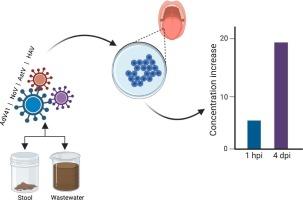人肠道病毒在唾液细胞系中的复制
IF 8
1区 环境科学与生态学
Q1 ENVIRONMENTAL SCIENCES
引用次数: 0
摘要
肠道病毒造成重大的公共卫生风险,经常在高浓度废水中检测到。虽然人们对废水中肠道病毒的检测和流行进行了广泛的研究,但单细胞系的传染性一直具有挑战性,特别是人类诺如病毒(NoV),过去很难培养。新出现的证据表明,唾液细胞系可能是肠道病毒的潜在复制工具。本研究旨在评价唾液细胞系在废水和粪便样品中复制和感染多种肠道病毒的可行性。我们的研究结果表明,所有测试的病毒都能在唾液细胞中成功复制,包括腺病毒41、星状病毒1型、轮状病毒、甲型肝炎病毒、柯萨奇病毒B3和;B1,肠病毒A71,呼肠孤病毒1型和NoV基因组GI和GII,显示病毒基因组浓度(GC)的平均对数增加范围为0.58至5.11。不同病毒的共感染,包括粪便样本,实验室适应和废水衍生的病毒,证明。总体而言,10/14(71%)的废水样本至少复制了一种病毒,8个样本(80%)显示合并感染(多个病毒同时复制)。在这些样本中,10/14(71%)的样本中检测到NoV RNA,但只有6/14(42%)的样本显示出NoV感染阳性。该研究表明,唾液细胞可以复制肠道病毒,提示其在环境肠道病毒传播中的作用,这将为公共和环境监测干预策略提供信息。本文章由计算机程序翻译,如有差异,请以英文原文为准。

Replication of human enteric viruses from wastewater in saliva cell lines
Enteric viruses cause significant public health risk and are frequently detected in wastewater at high concentrations. While viral detection and prevalence of enteric viruses from wastewater has been widely studied, infectivity in single cell lines has been challenging, particularly for Human Norovirus (NoV) which has been difficult to culture in the past. Emerging evidence suggests that salivary cell lines could be a potential replication tool for enteric viruses. This study aimed to evaluate the feasibility of saliva cell lines in the replication and infectivity of multiple enteric viruses in wastewater and fecal samples. Our results demonstrated successful replication of all tested viruses in saliva cells, including Adenovirus 41, Astrovirus type 1, Rotavirus, Hepatitis A virus, Coxsackievirus B3 & B1, Enterovirus A71, Reovirus type 1, and NoV genogroups GI and GII, demonstrating mean log increases in viral genome concentrations (GC) ranging from 0.58 to 5.11. Co-infections of different viruses, which included fecal sample, lab adapted and wastewater derived viruses, was demonstrated. Overall, 10/14 (71 %) wastewater samples had replication of at least one virus and 8 samples (80 %) showed co-infection (multiple viruses replicated concurrently). Among these samples, NoV RNA was detected by molecular measurement in 10/14 samples (71 %) samples but only 6/14 samples (42 %), showed evidence of positive NoV infectivity. This study shows that saliva cells can replicate enteric viruses suggesting its role in environmental enteric viral transmission which would inform strategies for public and environmental surveillance interventions.
求助全文
通过发布文献求助,成功后即可免费获取论文全文。
去求助
来源期刊

Science of the Total Environment
环境科学-环境科学
CiteScore
17.60
自引率
10.20%
发文量
8726
审稿时长
2.4 months
期刊介绍:
The Science of the Total Environment is an international journal dedicated to scientific research on the environment and its interaction with humanity. It covers a wide range of disciplines and seeks to publish innovative, hypothesis-driven, and impactful research that explores the entire environment, including the atmosphere, lithosphere, hydrosphere, biosphere, and anthroposphere.
The journal's updated Aims & Scope emphasizes the importance of interdisciplinary environmental research with broad impact. Priority is given to studies that advance fundamental understanding and explore the interconnectedness of multiple environmental spheres. Field studies are preferred, while laboratory experiments must demonstrate significant methodological advancements or mechanistic insights with direct relevance to the environment.
 求助内容:
求助内容: 应助结果提醒方式:
应助结果提醒方式:


